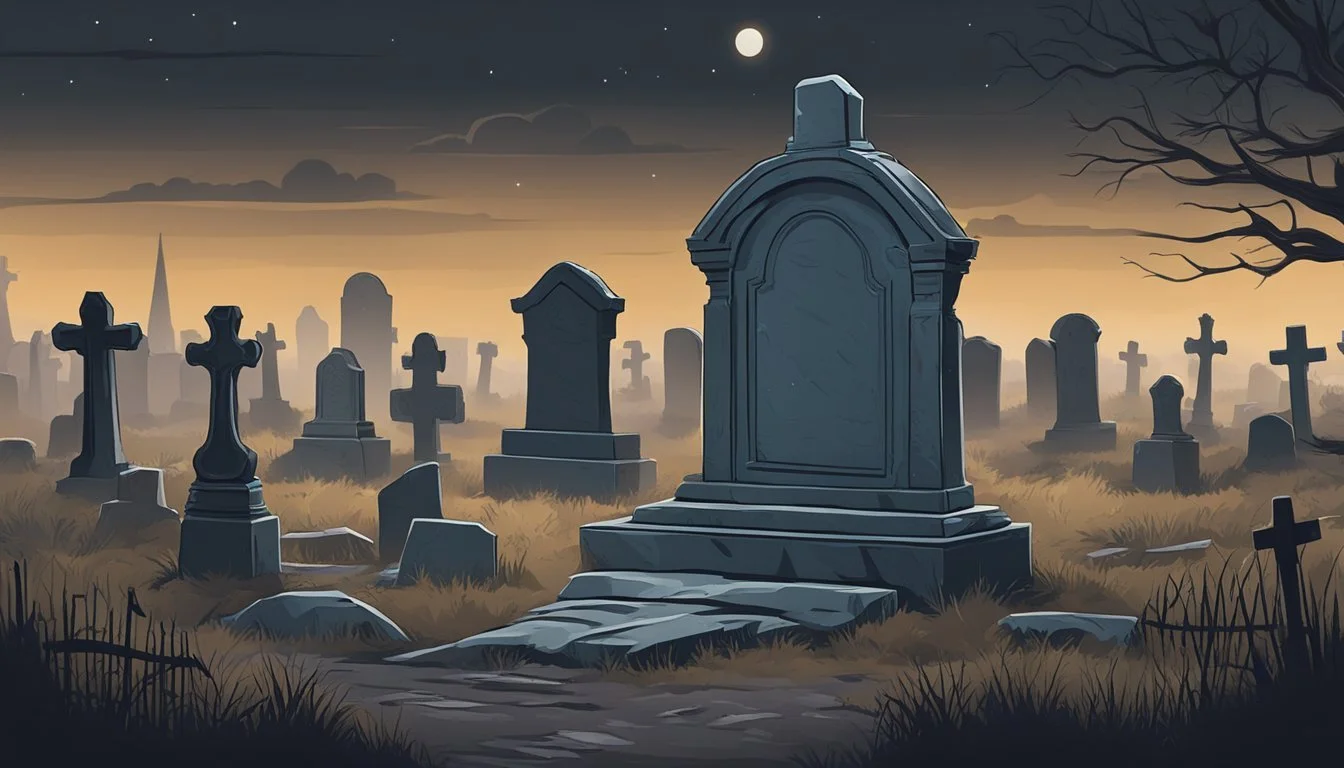H.H. Holmes' Last Con: America's First Serial Killer's Execution and Exhumation Revealed
H.H. Holmes, born Herman Webster Mudgett, gained notoriety as America's first serial killer in the late 19th century. His criminal career encompassed fraud, bigamy, and multiple murders. On May 7, 1896, Holmes met his fate at the gallows in Philadelphia, executed for the murder of Benjamin Pitezel.
The execution marked the end of Holmes' life of deception and violence. In his final days, he maintained his innocence and even attempted to orchestrate one last con. He claimed to have killed 27 people, though the actual number remains uncertain. This declaration fueled public fascination with his case, ensuring his infamy would persist long after his death.
Holmes' story didn't end with his execution. In 2017, his body was exhumed to address rumors that he had somehow escaped death. DNA testing confirmed the remains belonged to Holmes, putting to rest speculation about his final deception. This exhumation added a modern chapter to the tale of America's first recognized serial killer.
The Rise of Herman Webster Mudgett
Herman Webster Mudgett, later known as H.H. Holmes, transformed from a medical student to America's first notorious serial killer. His infamous "Murder Castle" in Chicago became the site of numerous heinous crimes.
From Medical School to Murder Castle
Mudgett enrolled at the University of Michigan Medical School in 1882. His charisma and intelligence helped him excel academically, but he soon turned to criminal activities.
He began engaging in insurance fraud, using cadavers from the medical school. This marked the start of his descent into more serious crimes.
After graduating, Mudgett moved to Chicago in 1886. He adopted the alias "Dr. Henry Howard Holmes" and started working at a pharmacy.
Construction of the Infamous Hotel
In 1889, Holmes purchased a lot in Chicago's Englewood neighborhood. He began constructing a three-story building that would later be dubbed the "Murder Castle."
The building's design included numerous secret rooms, hidden passages, and trap doors. These features allowed Holmes to carry out his gruesome activities undetected.
Holmes hired and fired multiple contractors during construction. This tactic prevented anyone from fully understanding the building's layout.
The ground floor housed Holmes' pharmacy and other shops. The upper floors contained his living quarters and elaborately designed torture chambers.
The Lurid Tales of Murder and Deception
H.H. Holmes orchestrated a reign of terror in Chicago, leaving a trail of victims and horrifying discoveries. His "Murder Castle" became the epicenter of his twisted schemes, concealing dark secrets within its walls.
Victims of the Murder Castle
Holmes lured unsuspecting victims to his Englewood hotel, particularly during the 1893 World's Fair. He targeted women, children, and business associates. Many guests checked in but never checked out.
The exact number of victims remains unknown. Estimates range from 20 to over 200 people. Holmes confessed to 27 murders, but the true count may be higher.
His victims often included those who trusted him most. He killed business partners for insurance money and romantic interests who threatened his schemes.
Ingenious Methods and Macabre Discoveries
Holmes designed his "Murder Castle" with sinister intent. The building featured secret rooms, hidden passages, and soundproof chambers. These allowed him to commit his crimes undetected.
Some rooms were equipped with gas lines, enabling Holmes to asphyxiate his victims. Others had peepholes for observing his captives. The basement housed a crematorium and acid vats for disposing of bodies.
Holmes utilized various murder methods:
Suffocation
Poisoning
Hanging
Live dissection
Investigators later uncovered bone fragments, bloodstained clothing, and other grisly evidence within the castle walls. These findings revealed the true extent of Holmes' depravity and cunning.
The Arrest and Trial of H.H. Holmes
H.H. Holmes' criminal activities came to an end with his arrest in Boston on November 17, 1894. His capture led to a sensational trial that captivated the American public and media.
Capture and Conviction
Detective Frank Geyer tracked Holmes across the country, following a trail of insurance fraud and murder. Holmes was apprehended in Boston and extradited to Philadelphia to face charges for Benjamin Pitezel's murder.
The trial began on October 28, 1895, in Philadelphia. Prosecutors presented evidence of Holmes' elaborate schemes and multiple killings. Holmes initially pleaded not guilty but later changed his plea to guilty of murder in the first degree.
On November 7, 1895, the jury found Holmes guilty after only a few hours of deliberation. Judge Michael Arnold sentenced him to death by hanging.
Public Interest and Media Circus
The Holmes case became a national sensation, with newspapers providing extensive coverage of the trial. Reporters flocked to Philadelphia, eager to report on every detail of the proceedings.
Holmes' charisma and manipulative nature were on full display during the trial. He often addressed the court directly, attempting to charm the jury and spectators.
The public's fascination with Holmes continued even after his conviction. While awaiting execution in Moyamensing Prison, Holmes wrote a confession claiming to have killed 27 people. This confession, later published in newspapers, further fueled the media frenzy surrounding the case.
The Execution of America's First Serial Killer
H.H. Holmes met his end on May 7, 1896 in Philadelphia. The notorious killer faced justice for his crimes as he approached the gallows.
The Final Moments
At 10:13 AM, Holmes ascended the scaffold. He remained calm and collected, maintaining his composure until the end. The executioner placed the noose around his neck.
Holmes addressed the crowd briefly. He denied killing anyone except two women, contradicting his earlier confessions. At 10:17 AM, the trapdoor opened.
Holmes's neck did not break instantly. He struggled for 15 minutes before being pronounced dead at 10:32 AM.
Holmes's Legacy of Dread
H.H. Holmes left an indelible mark on American criminal history. His "Murder Castle" in Chicago became infamous, a labyrinth of secret rooms and torture chambers.
Holmes's exact victim count remains unknown. He confessed to 27 murders, but some estimates go as high as 200. The uncertainty added to his mystique.
His execution did not end public fascination. Books, films, and TV shows continue to explore his crimes. Holmes became a symbol of evil genius, his name synonymous with cunning brutality.
Posthumous Events and Exhumation
H.H. Holmes' story continued long after his execution in 1896. Rumors of his escape persisted for decades, leading to a modern-day investigation to verify his true fate.
Claims of Innocence and Escape
Holmes maintained his innocence until the end, confessing to only two murders. This fueled speculation about his actual death count and whether he had truly been executed. Some believed Holmes had bribed guards to substitute another prisoner for his hanging, allowing him to escape.
Jeff Mudgett, Holmes' great-great-grandson, popularized these theories in recent years. He claimed Holmes fled to South America, citing alleged sightings and family lore.
These persistent rumors led to doubts about the identity of the body buried in Holmes' grave at Holy Cross Cemetery in Yeadon, Pennsylvania.
Legacy Verification: The Exhumation
In 2017, a team from the University of Pennsylvania exhumed Holmes' remains to settle the debate once and for all. The excavation revealed a pine box containing a skeleton encased in cement, just as historical records described.
Forensic analysis provided conclusive evidence:
DNA testing matched the remains to Holmes' descendants
Dental records aligned with those taken during Holmes' lifetime
The skull showed a mustache-shaped stain consistent with contemporary descriptions
These findings definitively proved that H.H. Holmes was indeed executed and buried as officially reported, putting an end to decades of speculation about his fate.
The Cultural Impact of H.H. Holmes
H.H. Holmes left an indelible mark on American culture, inspiring numerous works of literature and film. His story has been reinterpreted by historians and true crime enthusiasts, shaping public perceptions of serial killers.
Literature and Film Adaptations
Erik Larson's 2003 book "The Devil in the White City" brought H.H. Holmes back into the spotlight. The non-fiction work intertwines Holmes' story with that of the 1893 Chicago World's Fair. It became a bestseller and reignited interest in the infamous killer.
The book's success led to plans for a film adaptation, with Leonardo DiCaprio attached to star as Holmes. This project has been in development for years, demonstrating the enduring fascination with Holmes' story.
Several documentaries have explored Holmes' life and crimes. The History Channel's "American Ripper" series examined claims that Holmes was also Jack the Ripper.
Historical Interpretations
Historians have debated the true extent of Holmes' crimes. Some argue that his murderous exploits were exaggerated by sensationalist reporting of the era.
Others view Holmes as a product of his time, reflecting the dark underbelly of America's Gilded Age. His story has been used to critique the rapid urbanization and industrialization of late 19th-century Chicago.
Holmes' "Murder Castle" has become a subject of particular interest. Though no longer standing, it continues to capture the public imagination as a symbol of his cunning and cruelty.
Holmes's Schemes Beyond the Murders
H.H. Holmes engaged in a variety of criminal activities beyond his infamous murders. His schemes ranged from elaborate insurance fraud to smaller-scale swindles, showcasing his cunning and ruthlessness.
Life Insurance Scam and Benjamin Pitezel
Holmes orchestrated a complex life insurance scam involving Benjamin Pitezel, his business partner and eventual victim. In 1894, Holmes convinced Pitezel to fake his own death to collect a $10,000 life insurance policy. The plan took a sinister turn when Holmes actually murdered Pitezel.
He then manipulated Pitezel's wife into believing her husband was still alive. Holmes collected the insurance money, keeping most of it for himself. This scheme demonstrated his ability to exploit personal relationships for financial gain.
The fraud unraveled when authorities discovered Pitezel's true fate. This led to the exposure of Holmes's wider criminal activities.
Broader Swindles and Frauds
Holmes's criminal career extended far beyond murder and insurance fraud. In Boston, he worked as a swindler, using various aliases to con people out of money. He frequently engaged in check fraud and forgery.
Holmes also ran smaller scams, selling fake medicines and miracle cures. He leveraged his medical background to appear credible in these schemes. His charm and persuasive abilities made him particularly effective at deceiving victims.
He often left a trail of unpaid debts, moving from city to city to avoid creditors. Holmes's broader frauds reveal a pattern of constant deception and financial manipulation throughout his life.
Investigating the Mind of H.H. Holmes
H.H. Holmes displayed complex psychological traits that motivated his crimes. His confessions and writings provide insight into his mindset and criminal behavior.
Psychological Profile
H.H. Holmes exhibited traits of psychopathy and narcissism. He was charismatic and manipulative, able to charm his victims and business associates. Holmes showed a lack of empathy and remorse for his crimes.
His intelligence and medical knowledge allowed him to carry out elaborate schemes. Holmes demonstrated meticulous planning in constructing his "Murder Castle" in Chicago.
Experts believe Holmes derived satisfaction from outsmarting others. He viewed his victims as objects to be exploited rather than human beings.
Holmes's Autobiography and Confessions
Holmes wrote an autobiography while awaiting execution in 1896. In it, he claimed to have killed 27 people, though the true number remains unknown.
His confessions were often contradictory. Holmes admitted to some murders while denying others. He seemed to enjoy toying with authorities and the public.
The autobiography reveals Holmes's ego and desire for notoriety. He portrayed himself as misunderstood and wrongly accused of some crimes.
Holmes's writings show calculated attempts to control his narrative. He aimed to shape public perception of his life and crimes even after death.





